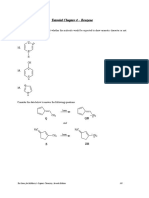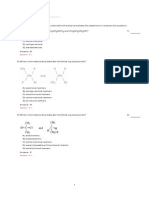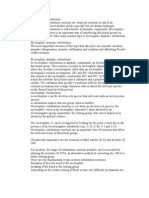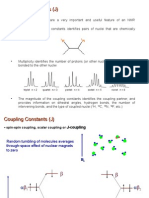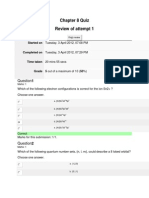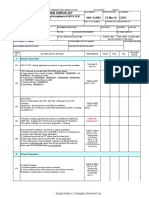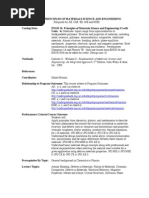0 ratings0% found this document useful (0 votes)
777 viewsIR Spectroscopy Problem Set 1
Infrared spectroscopy is used to identify organic compounds by measuring the frequencies of infrared radiation they absorb. Each compound absorbs specific frequencies corresponding to the stretching and bending vibrations of its chemical bonds. By analyzing the absorption bands in a compound's IR spectrum, one can determine the functional groups present and identify the compound. This document provides an IR spectroscopy problem set asking students to match IR spectra to structures, label peaks, and identify functional groups.
Uploaded by
Jules BrunoCopyright
© Attribution Non-Commercial (BY-NC)
Available Formats
Download as PDF, TXT or read online on Scribd
0 ratings0% found this document useful (0 votes)
777 viewsIR Spectroscopy Problem Set 1
Infrared spectroscopy is used to identify organic compounds by measuring the frequencies of infrared radiation they absorb. Each compound absorbs specific frequencies corresponding to the stretching and bending vibrations of its chemical bonds. By analyzing the absorption bands in a compound's IR spectrum, one can determine the functional groups present and identify the compound. This document provides an IR spectroscopy problem set asking students to match IR spectra to structures, label peaks, and identify functional groups.
Uploaded by
Jules BrunoCopyright
© Attribution Non-Commercial (BY-NC)
Available Formats
Download as PDF, TXT or read online on Scribd
You are on page 1/ 0
Problem Set 3 IR Spectroscopy 80
CHEM 3012 - Spring 2009 Name ______________________________
Organic Chemistry Laboratory I
Problem Set 3 Infrared Spectroscopy
Infrared (IR) absorption spectroscopy is the measure of the amount of radiation
absorbed by compounds within the infrared region of the electromagnetic spectrum. The
absorption of infrared radiation is a quantized process, which means only selected
frequencies (energies) of infrared radiation are absorbed by a molecule. Each absorption
band corresponds to energy changes related to the two types of vibration, stretching and
bending of chemical bonds, in covalent molecules. From these absorption bands, or
peaks in the spectrum, the presence or absence of certain functional groups of a
compound can be determined.
For this problem set:
a) Match the four structures with the four IR spectra in each set. Use a table of
specific IR absorptions for various functional groups to help you identify
the structures.
b) Indicate and label the important peaks in each spectrum by drawing the type of
bond next to its corresponding peak.
c) Label all the functional groups that are present in each compound.
d) Show your work.
Required Reading: Wade Ch. 12, pg 508-537 (or Mayo pg 146-162)
Problem Set 3 IR Spectroscopy 81
1. a) b)
answer ______________________ answer ______________________
c) d)
answer ______________________ answer ______________________
OH
O
HO
O
OH
O
OH
Choices
Problem Set 3 IR Spectroscopy 82
2. a) b)
answer ______________________ answer ______________________
c) d)
answer ______________________ answer ______________________
NH
2
NH
2
O
N
O
H
N
N
Choices
Problem Set 3 IR Spectroscopy 83
3. a) b)
answer ______________________ answer ______________________
c) d)
answer ______________________ answer ______________________
CN
Choices
Problem Set 3 IR Spectroscopy 84
4. a) b)
answer ______________________ answer ______________________
c) d)
answer ______________________ answer ______________________
O
CO
2
H
N
OH
H
CN
NH
2
Choices
You might also like
- Organic Chemistry II Practice Exam #2 Answer KeyNo ratings yetOrganic Chemistry II Practice Exam #2 Answer Key7 pages
- Challenge Problems in David Klein Chap 7-17No ratings yetChallenge Problems in David Klein Chap 7-1732 pages
- A Practical Beginner's Guide To Cyclic Voltammetry: Supporting InformationNo ratings yetA Practical Beginner's Guide To Cyclic Voltammetry: Supporting Information29 pages
- A Textbook of Physical Chemistry - Volume 1: January 2018100% (2)A Textbook of Physical Chemistry - Volume 1: January 201821 pages
- Tutorial Chapter 4 - Benzene: Test Items For Mcmurry'S Organic Chemistry, Seventh Edition 145No ratings yetTutorial Chapter 4 - Benzene: Test Items For Mcmurry'S Organic Chemistry, Seventh Edition 1454 pages
- MCQ Question Bank For Unit 1: A Is Lattice Parameter) Is (B) A/2No ratings yetMCQ Question Bank For Unit 1: A Is Lattice Parameter) Is (B) A/214 pages
- Stereochemistry Basic Concepts Useful Notes For StudentsNo ratings yetStereochemistry Basic Concepts Useful Notes For Students26 pages
- Lecture Notes Chapter-12-Aldehydes, Ketones & Carboxylic AcidsNo ratings yetLecture Notes Chapter-12-Aldehydes, Ketones & Carboxylic Acids26 pages
- Reactivity of Furan Pyrrole Thiophene AnNo ratings yetReactivity of Furan Pyrrole Thiophene An19 pages
- 2APHY Nuclear Physics Assignment One Mid Unit 2009No ratings yet2APHY Nuclear Physics Assignment One Mid Unit 20094 pages
- P4 Hazards and Uses of Emission and Background Radiation Phys OnlyNo ratings yetP4 Hazards and Uses of Emission and Background Radiation Phys Only69 pages
- 2024 Msce Physics Pi Mwanza Cluster MockNo ratings yet2024 Msce Physics Pi Mwanza Cluster Mock12 pages
- 2017 Unit 4 Chemistry KTT 3 Instrumentation - Question BookNo ratings yet2017 Unit 4 Chemistry KTT 3 Instrumentation - Question Book12 pages
- 2APHY Nuclear Physics Test One Mid Unit 2009No ratings yet2APHY Nuclear Physics Test One Mid Unit 20094 pages
- Test 2 Spring 2005 (Acid & Base Titrations)No ratings yetTest 2 Spring 2005 (Acid & Base Titrations)6 pages
- Lichter CHM1045 Quizzes (8A) (Spring 2012)No ratings yetLichter CHM1045 Quizzes (8A) (Spring 2012)8 pages
- Lichter CHM1045 Quizzes (10A) (Spring 2012)No ratings yetLichter CHM1045 Quizzes (10A) (Spring 2012)8 pages
- Lichter CHM1045 Quizzes (9A) (Spring 2012)No ratings yetLichter CHM1045 Quizzes (9A) (Spring 2012)8 pages
- Lichter CHM1045 Quizzes (5A-5B) (Spring 2012)No ratings yetLichter CHM1045 Quizzes (5A-5B) (Spring 2012)9 pages
- Important Definitions: Chapter 9 Review Sheet - StereochemistryNo ratings yetImportant Definitions: Chapter 9 Review Sheet - Stereochemistry4 pages
- Lichter CHM1045 Quizzes (1A-1F) (Spring 2012)No ratings yetLichter CHM1045 Quizzes (1A-1F) (Spring 2012)19 pages
- Chapter 10 Catalytic Halogenation ProblemsNo ratings yetChapter 10 Catalytic Halogenation Problems1 page
- DPP P Block 17 18 Nitesh Devnani - 240828 - 105447No ratings yetDPP P Block 17 18 Nitesh Devnani - 240828 - 1054477 pages
- Encyclopedia of Pharmaceutical TechnologyNo ratings yetEncyclopedia of Pharmaceutical Technology3,606 pages
- Lab 11 Acids, Bases, PH, Hydrolysis, and Buffers67% (3)Lab 11 Acids, Bases, PH, Hydrolysis, and Buffers10 pages
- Introductory Microbiology Laboratory Manual PDF100% (3)Introductory Microbiology Laboratory Manual PDF91 pages
- Effect of Polypropylene Fibres On Strength and Durability Performance of M-Sand Self Compacting ConcreteNo ratings yetEffect of Polypropylene Fibres On Strength and Durability Performance of M-Sand Self Compacting Concrete22 pages
- 1) Flow: 239869283.xls - Ms - Office Piping Pressure Drop and Pump Design Calculation Sheet100% (2)1) Flow: 239869283.xls - Ms - Office Piping Pressure Drop and Pump Design Calculation Sheet4 pages
- Reticulocyte Hemoglobin Equivalent As A Potential Marker PDFNo ratings yetReticulocyte Hemoglobin Equivalent As A Potential Marker PDF10 pages




















